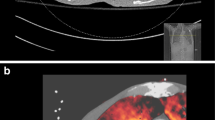Abstract
Pulmonary embolism (PE) is a common disease with considerable mortality. There are no specific signs or symptoms of PE; the diagnosis relies on imaging tests. The development of multi-detector computed tomography has led to an improvement in the diagnosis of PE due to faster scanning and improved spatial resolution along the longitudinal axis of the patient. Apart from fast scanning and thin collimation, optimal arterial attenuation remains one of the most crucial determinants of sufficient depiction of the pulmonary arteries. Arterial attenuation over time is generally determined by iodine flow concentration, which may be increased either by raising the contrast medium flow rate, and/or by using a high iodine concentration contrast medium. The scan duration necessary for imaging the whole thorax ranges from about 20 s with a four-detector row scanner to about 5 s with a 64-detector row detector scanner. The collimation ranges from 0.5 mm to 1 mm depending on the scanner used. This enables the most detailed display of the pulmonary arteries.
Bolus triggering devices are a valuable tool for accurate timing of scanning. The administration of the contrast material bolus is performed using a power injector at a flow rate of about 4 mL/s. A saline flush immediately after contrast material administration avoids pooling of the contrast material in the arm veins and in the injection system and reduces perivenous artifacts in the superior vena cava. The use of a high concentration contrast material significantly improves attenuation of the pulmonary arteries leading to better visualisation of sub-segmental and lower order pulmonary arteries in multi-row-detector-CTA. In addition, the higher attenuation may improve the conspicuity of emboli within the pulmonary arteries.
Similar content being viewed by others
Author information
Authors and Affiliations
Corresponding author
Rights and permissions
About this article
Cite this article
Tillich, M., Schoellnast, H. Optimized imaging of pulmonary embolism. Eur Radiol Suppl 15 (Suppl 5), e66–e70 (2005). https://doi.org/10.1007/s10406-005-0167-9
Issue Date:
DOI: https://doi.org/10.1007/s10406-005-0167-9




